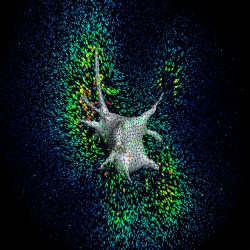
The simple adaptation, based on a method of measurement currently used in nano-electronics, could also give STMs significant new capabilities — including the ability to sense temperatures in spots as small as a single atom.
But while current can change in a nanosecond, measurements with the STM are painfully slow. And the limiting factor is not in the signal itself: It’s in the basic electronics involved in analyzing it. A theoretical STM could collect data as fast as electrons can tunnel — at a rate of one gigahertz, or 1 billion cycles per second of bandwidth. But a typical STM is slowed down by the capacitance, or energy storage, in the cables that make up its readout circuitry — to about one kilohertz (1,000 cycles per second) or less.
Researchers have tried a variety of complex remedies. But in the end, said Schwab, an associate professor of physics at Cornell, the solution was surprisingly simple. By adding an external source of radio frequency (RF) waves and sending a wave into the STM through a simple network, the researchers showed that it’s possible to detect the resistance at the tunneling junction — and hence the distance between the probe and sample surface — based on the characteristics of the wave that reflects back to the source.
The technique, called reflectometry, uses the standard cables as paths for high-frequency waves, which aren’t slowed down by the cables’ capacitance.
“There are six orders of magnitude between the fundamental limit in frequency and where people are operating,” said Schwab. With the RF adaptation, speeds increase by a factor of between 100 and 1,000. “Our hope is that we can produce more or less video images, as opposed to a scan that takes forever.”
The setup also offers potential for atomic resolution thermometry — precise measurements of temperature at any particular atom on a surface — and for motion detection so sensitive it could measure movement of a distance 30,000 times smaller than the size of an atom.

Brian Wang is a Futurist Thought Leader and a popular Science blogger with 1 million readers per month. His blog Nextbigfuture.com is ranked #1 Science News Blog. It covers many disruptive technology and trends including Space, Robotics, Artificial Intelligence, Medicine, Anti-aging Biotechnology, and Nanotechnology.
Known for identifying cutting edge technologies, he is currently a Co-Founder of a startup and fundraiser for high potential early-stage companies. He is the Head of Research for Allocations for deep technology investments and an Angel Investor at Space Angels.
A frequent speaker at corporations, he has been a TEDx speaker, a Singularity University speaker and guest at numerous interviews for radio and podcasts. He is open to public speaking and advising engagements.

